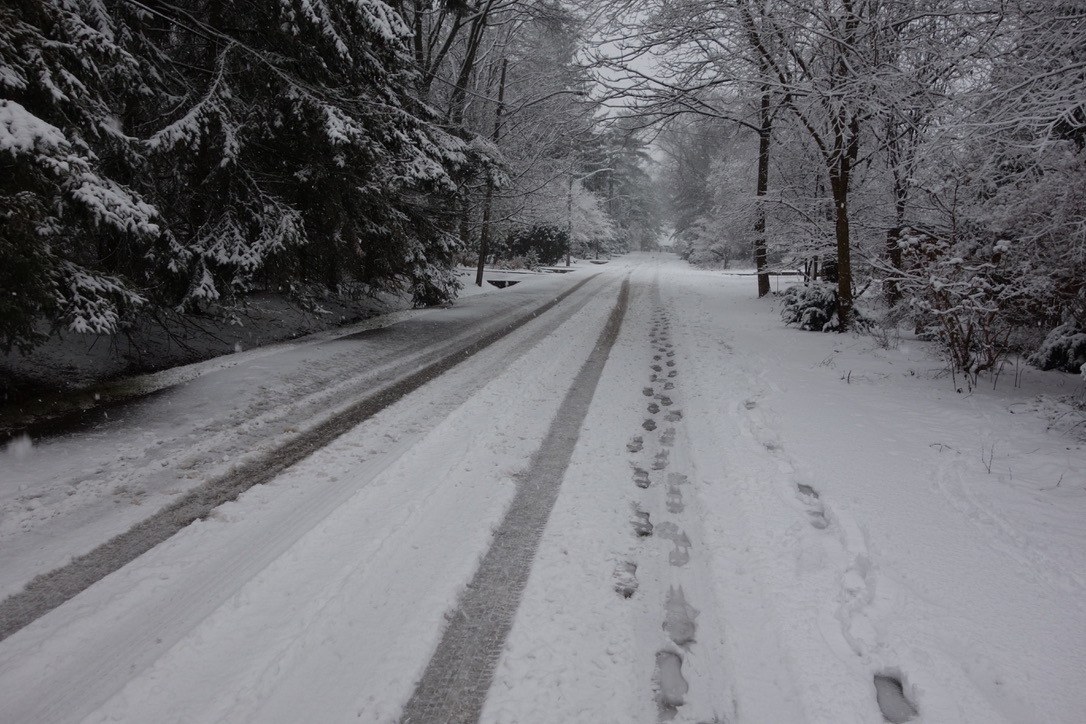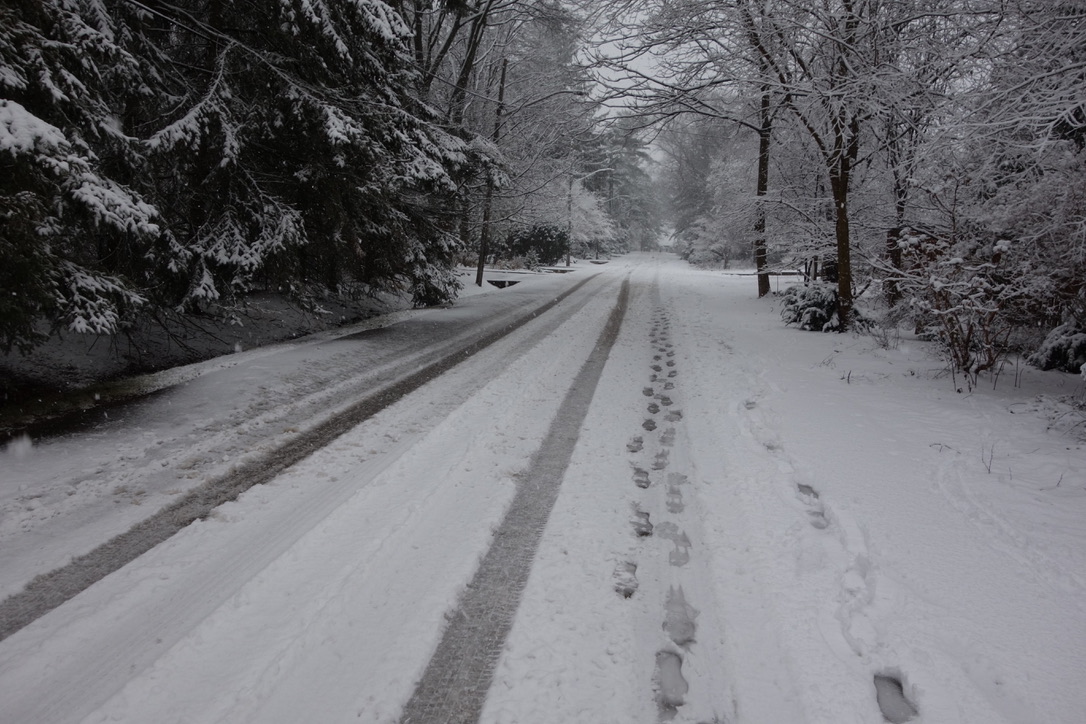EPISODE 489 CAN A SNOWFLAKE CAPTURE THE CORONA VIRUS? (FACTS AND FICTION)
alan skeoch
dec. 18,2021
“Marjorie, this corona virus is starting to get to me.”
“How so? Are you any different than others?”
“No. But the goddamn virus is changing my life. And not for the best.”
“Get your coat on. Let’s take Woody for a walk and calm down.”
“The streets are empty. Everybody is hived away.”
“Not everybody. There are tracks.”
“Thos are our tracks.”
“READERS will have trouble separating fact from fiction in this episode Marjorie”
“Not Surprised.”
TODAY our streets were bombarded by millions of large heavy snowflakes.
And at the same time parts of our neighbourhood harboured billions, perhaps hundreds
of billions of the corona virus. Our streets are empty
Is it safe to go for a walk? Unmasked? Which got me to thinking. The virus is
so small that it cannot be detected even by sophisticated microscopes. And the
virus is so light that it can float around in the air quite freely. Which made me
think.
“What are viruses anyway? Animal, vegetable or mineral?
Viruses are microscopic parasites, generally much smaller than bacteria. They lack the capacity to thrive and reproduce outside of a host body.
Predominantly, viruses have a reputation for being the cause of contagion. Widespread events of disease and death have no doubt bolstered such a reputation. The 2014 outbreak of Ebola in West Africa, and the 2009 H1N1/swine flu pandemic (a widespread global outbreak) likely come to mind.
“How long have the little bastards been around?
“Some scientists say they only appeared 8,000 BCE years ago. Others say they are 55 million yeas old and co developed with bats.
Quite a difference in opinion.”
“How big are the snowflakes?”
“Big enough to see them until they disappear.”
“Which makes me think. The virus seems to be everywhere…even out here.”
“According to the experts, yes…everywhere…at least in spots all around he
earth.”
“Even out here on Glenburnie Road?”
“Now here’s an idea…Suppose one of these big wet snowflakes struck a tiny corona virus. Wouldn’t the
snowflake capture the virus and take it to the ground. Wouldn’t a million snowflakes
take a billion corona virus to the ground? Cleanse our air? “
“Sort of silly comments, alan”
“Now here is a mathematical problem. The Question:
“How many corona virus can be caught by one fluffy snowflake?”
“Has anybody ever answered?
“Yes, the mathematician Christian Yates did…in a way that is similar…”
(See Conclusion…after the silly stuff)
“WHAT DOES A CORONAVIRUS LOOK LIKE?”
Seems to be quite attractive . At least according to the editors of Scientific American (July 2020)
who put this image on the front over of the magazine in 2020. NOT THE REAL COLOURS I IMAGINE.
You may wonder what those yellow stems are…They are ‘grabbers’ that latch on to your lung cells
and then allow the Covid 19 Virus to squeeze into lung cells. In other words those ‘grabbers’ are
not nice. In many cases infected people do not even know the Covid Virus is in their lungs.
TWO QUESTIONS
On October 16 ,2020 Australian study says the SARS COVID 2 virus can live for 28 days (Oct. 16, 2020)
2) How much space would be needed if we gathered all the Corona Viruses in the world??”
“Suppose we gathered all the Corona Virus on the earth right now. How much space would we
need to keep them?””
Below is the answer given by mathematician Chrisitan Yates

If you collected up every Sars-CoV-2 virus particle in the world, it would fit inside a soft drinks can, writes the mathematician Christian Yates.
W
When I was asked to calculate the total volume of Sars-CoV-2 in the world for the BBC Radio 4 show More or Less, I will admit I had no idea what the answer would be. My wife suggested it would be the size of an Olympic swimming pool. “Either that or a teaspoon,” she said. “It’s usually one or the other with these sorts of questions.”
So how to set about calculating an approximation of what the total volume really is?
Fortunately, I have some form with these sorts of large-scale back-of-the-envelope estimations, having carried out a number of them for my book The Maths of Life and Death. Before we embark on this particular numerical journey, though, I should be clear that this is an approximation based on the most reasonable assumptions, but I will happily admit there may be places where it can be improved.
You might also be interested in:
So where to start? We’d better first calculate how many Sars-CoV-2 particles there are in the world. To do that, we’ll need to know how many people are infected. (We’ll assume humans rather than animals are the most significant reservoir for the virus.)
The amount of virus that each of the people currently infected will carry around with them (their viral load) depends on how long ago they were infected. On average, viral loads are thought to rise and peak about six days after infection, after which they steadily decline.
Of all the people who are infected now, those who got infected yesterday will contribute a little to the total count. Those who were infected a couple of days ago will contribute a little more. Those infected three days ago a little more still. On average, people infected six days ago will have the highest viral load. This contribution will then decline for people who were infected seven or eight or nine days ago, and so on.
The final thing we need to know is the number of virus particles people harbour at any point during their infection. Since we know roughly how viral load changes over time, it’s enough to have an estimate of the peak viral load. An unpublished study took data on the number of virus particles per gram of a range of different tissues in infected monkeys and scaled up the size of tissue to be representative of humans. Their rough estimates for peak viral loads range from one billion to 100 billion virus particles.
Let’s work with a value in the middle of this range (the geometric mean) at 10 billion. When you add up all the contributions to the viral load of each of the 3 million people who became infected on each of the previous days (assuming this 3 million rate is roughly constant) then we find that there are roughly 200 quadrillion (2×10¹⁷ or two hundred million billion) virus particles in the world at any one time.
CONCLUSION
“SO, Alan, How many virus could we gather on our walk in the snow?
“Not enough to cover the head of a pin.?
“How do you know that?”
“I have no bloody idea.”
“Could we put all the virus particles in the world into our schoolhouse…bird house?”
“Apparently so.”
“Do you think any Covid 19 has been captured by these fluffy snowflakes?”
“You flatter my intelligence. Just for fun count the snowlafes on the school house roof
and multiply it by a billion billion or more…that’s the space needed for the Covid virus.
“Stick with the pop can image…makes more sense.
POST SCRIPT…NEXT DAY
“MARJORIE, I see the TTC has ordered all windows on busses to be open.”
“Why?”
“To blow as many of the Covid particles out the windows i imagine.”
“How did the Covid particles get in the busses anyway?”
“From the lungs of infected people. A lot of people do not even know they are infected.”
“Well the open window trick won’t work today?”
“Why nor?”
“The sun is out…beautiful day.”
“What has that got to do with limiting the Covid viruses?”
“No falling snowflakes to catch the viruses and take them to the ground.”
“Sometimes you say stupid things, Alan.”
“Right … the snowflake caper would not help much anyway.”
“Why not?”
“Those Australian researchers said the Covid virus could live for 28 days on surfaces.”
“Really?”
“Means we could pick the virus up on our boots.”
“Now that is a really stupid answer.”
“Your job is to separate fact from fiction…now!”
FACTS
1) UP TO 28 DAY LIFE OF VIRUS
2) VIRUS REPRODUCED IN HUMAN LUNGS… AND EXPECCED
3) TTC BUSSES NOW HAVE OPEN WINDOWS
4) ALL COVID VIRUSES ON EARTH COULD BE PUT IN A POP CAN
5) VIRUSSES EMERGED SOMETIME BETWEEN 8,000 AND 55 MILLION YEARS AGO
6) THE LITTLE STALKS ON THE VIRUS ARE ‘GRABBERS’ THAT SEIZE LUNG CELLS
FICTION
1) SNOWFLAKES COULD CATCH VIRUSES
2) VIRUSES ON OUR BOOTS
3) OPEN AIR IS AS DANGEROUS AS CROWDED BARROOM
4) STREETS ARE EMPTY…NOT SO BECAUSE LIFE GOES ON DESPITE COVID 19
TODAY…DECEMBER 19, 2021…THE SUN IS SHINING











